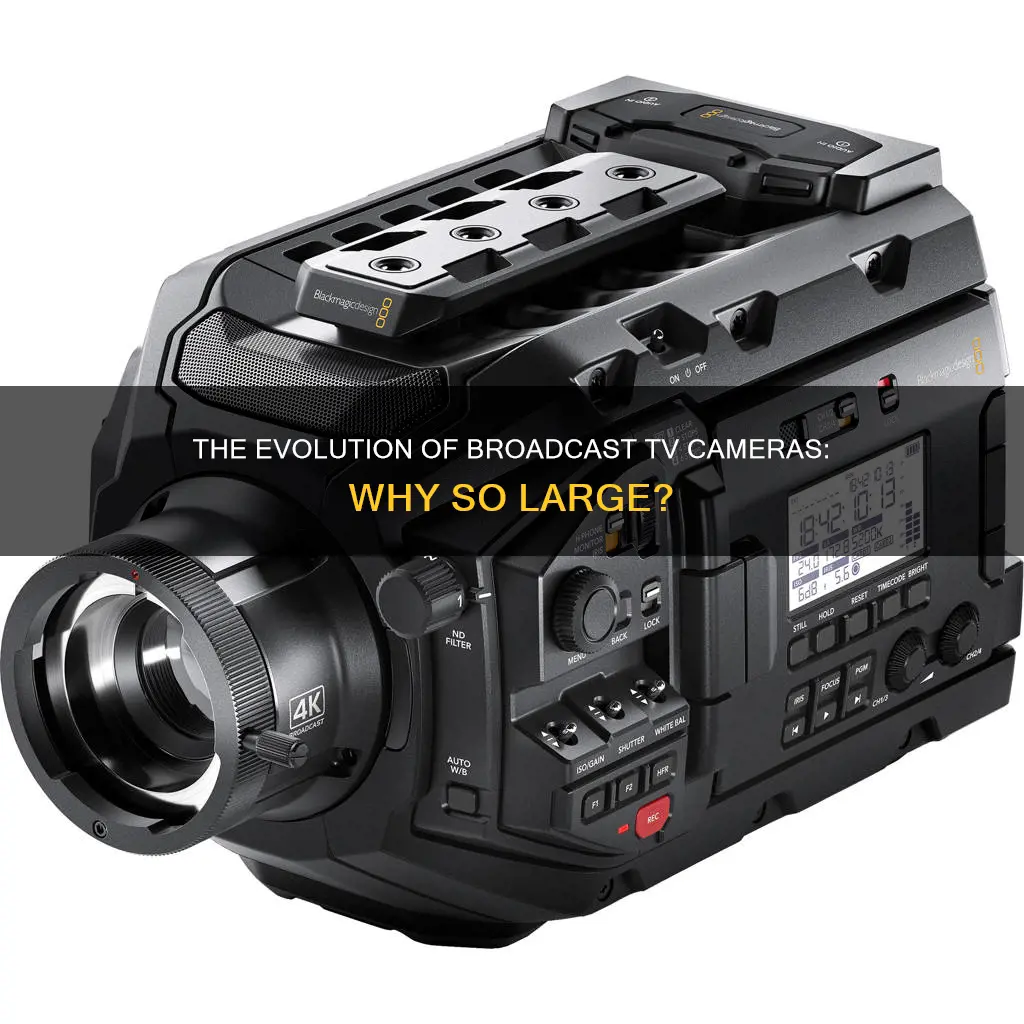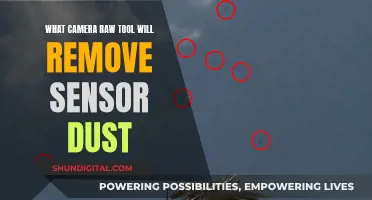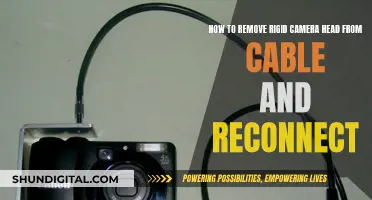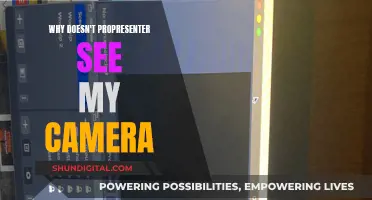
Broadcast TV cameras are large due to the size of the lenses, which can cost up to $200,000. These lenses are large because they are designed to be extremely versatile, with a wide maximum aperture, parfocal magic (staying pin-sharp during zooms), and powerful motors for aperture, zoom, and focus control. The lenses are also large to accommodate the electronics that control the camera's functions, such as the processor and light sensors. In addition to the lenses, the tripods that support these cameras are also large and expensive, providing a stable base for the camera even in challenging conditions.
| Characteristics | Values |
|---|---|
| Lens | Capable of zooming in on the action from kilometres away without missing a beat; parfocal; stable; uses powerful-but-accurate motors for aperture, zoom, and focus control |
| Focal Length | Comprehensive; can keep its subject in razor-sharp focus while smoothly transitioning through zoom levels |
| Housing | Contains electronic components that control the zoom and focus, alongside motorized servos that curate seamless scene transitions |
| Electronics | Processors calculate and control every motorized nuance, responding to a director's remote commands; light sensors tirelessly tweak exposure for consistent brilliance |
| Tripod | Provides a steadfast base for the camera to capture clear shots; equipped with fluid heads for smooth motion and unshakeable support |
| Monitors and Controls | Ensure that the visual symphony is pitch-perfect, with every tilt and pan executed with precision; remote controls guide the camera, ensuring that every scene transition is smooth |
| Camera Body | Advanced imaging sensors and circuitry that process data at breakneck speeds, ensuring that no action is too fast to capture; efficiently dissipates heat |
What You'll Learn
- The lens is the most expensive component, costing up to $200,000
- The camera body is a sophisticated piece of tech with advanced imaging sensors
- Electronics control the motors and calculate nuances with precision
- Tripods are essential for stability and can cost $20,000
- Remote controls and monitors allow for smooth transitions

The lens is the most expensive component, costing up to $200,000
The lens is the priciest part of a broadcast camera setup, with a price tag of up to $200,000. This high cost is due to the lens's ability to capture objects with high precision from kilometres away. This requires long focal lengths, which are expensive. These lenses also need valuable zoom capabilities and a large focal range, meaning they have par-focal capability—they can maintain focus when changing zoom levels without any loss in clarity or detail.
A broadcast camera lens with a 900mm focal length and an f4.5 max aperture, for example, needs an optical diameter of 200mm. This, in turn, requires a larger box housing to fit all the components, including the electronics that control zooming and focusing. Motorised servos also play a role in smoothly transitioning between scenes.
The lens's high-quality glass elements ensure sharp image capture, even from long distances. The lens used in the Zebra Zone video is a Fujinon UA107 that covers 8.6-900mm (1800mm with a built-in extender) at a maximum aperture of f/1.7 – f/4.5 (f/8 at 1800mm). The lens shown in the video by John Aldred is a Fujinon 4K UHD 8.4-900mm f/1.7 4K.
Hisense Roku TV: Built-in Camera or Not?
You may want to see also

The camera body is a sophisticated piece of tech with advanced imaging sensors
The camera body is a powerhouse of technology, a complex system that houses advanced imaging sensors and circuitry. It is designed to process data at lightning speed, ensuring that not a moment of the action is missed. This intricate dance of technology is meticulously engineered to work in harmony, capturing and delivering live TV with impeccable precision.
The imaging sensors within the camera body are key to its functionality. They are responsible for converting light into electrical signals, which are then processed to create a digital image. These sensors are highly sensitive and capable of capturing a vast range of light levels, from dimly lit studios to bright outdoor events. Their dynamic range allows them to capture fine details in both shadows and highlights, ensuring that the final image is of the highest quality.
The circuitry within the camera body is equally impressive. It facilitates high-speed data processing, enabling the camera to keep up with the demands of live broadcasting. This circuitry includes processors and specialised chips that enhance the camera's capabilities, such as improving low-light performance, reducing noise, and optimising colour accuracy. The circuitry also enables various shooting modes and settings, providing camera operators with the flexibility to adapt to different lighting conditions and creative requirements.
The camera body's design also prioritises heat dissipation, ensuring that the equipment can operate continuously without overheating. This is crucial for live broadcasts, where there is no room for equipment failure. The body's structure and materials are carefully engineered to dissipate heat efficiently, maintaining optimal performance even during extended use.
Furthermore, the camera body often incorporates advanced stabilisation technology. While the tripod provides a stable base, the camera body may include additional stabilisation mechanisms to compensate for minor vibrations or movements. This ensures that the image remains steady and clear, even when the camera is subjected to external factors such as wind or dynamic movements during sporting events.
The camera body is the heart of the broadcast setup, and its advanced imaging sensors and circuitry are what set it apart. It is designed to be versatile, adaptable, and reliable, meeting the demanding requirements of live television. The camera body's intricate technology ensures that viewers at home experience the action as if they were there, witnessing every detail with crystal-clear clarity.
Watching Construction Sites: Cameras and their Best Angles
You may want to see also

Electronics control the motors and calculate nuances with precision
Electronics are the brains behind the brawn of broadcast TV cameras. They are the unsung heroes, controlling and calculating every nuance with precision. Processors are the maestros, responding to the director's remote commands with the precision of a Swiss watch. They ensure that the camera smoothly transitions through zoom levels, maintaining pin-sharp focus on the subject, whether it is a whisper away or on the horizon.
The electronics also include light sensors that tirelessly tweak the exposure to ensure consistent brilliance. These components are essential for sculpting the bulky silhouettes that have become iconic in media houses across the globe. The processor calculates and controls every motorized nuance, ensuring the camera captures every shot with impeccable precision. This precision is non-negotiable in the unforgiving world of live broadcasting, where every second counts and there are no do-overs.
The electronics in broadcast TV cameras are designed to be adaptable, allowing the camera to adjust to any environment, from the controlled setting of a talk show to the unpredictable nature of sports coverage. They are built to withstand the elements, providing clear shots even when nature does its worst. The electronics also enable the camera to capture fast-paced action, ensuring that no moment is too quick for the camera to capture.
In addition to the electronics, the camera's stabilisation system plays a crucial role in ensuring smooth and steady shots. The Herculean tripods that anchor these setups scoff at the elements, providing an unshakeable foundation for the camera. They are equipped with fluid heads that promise buttery smooth motion, ensuring the camera glides effortlessly without any jerky movements.
Mastering Camera Watches: A Step-by-Step Guide
You may want to see also

Tripods are essential for stability and can cost $20,000
When it comes to broadcast TV cameras, stability is essential to ensure clear and sharp images. While there are various components and techniques involved in achieving stability, one crucial element is the use of tripods.
Tripods provide a stable base for the camera, distributing the weight evenly across their three-legged design. This design inherently resists tipping over, providing a solid foundation for the camera setup. Additionally, the adjustability of tripods enhances their stability. They feature adjustable leg angles and locking mechanisms, allowing operators to customise the height and angle of the tripod to adapt to different terrains and surfaces.
Moreover, tripods often include advanced features that further improve stability. For instance, some tripods have built-in stabilisers or vibration reduction systems, which minimise camera shake. Others may have a hook on the underside of the centre column, allowing the addition of extra weight for increased stability, especially in windy conditions.
The cost of a tripod can vary, and for broadcast TV cameras, the price can be significant. A tripod suitable for broadcast TV cameras may cost around $20,000. This investment ensures the necessary stability and precision required for high-quality broadcasts.
In summary, tripods are essential for stability in broadcast TV camera setups, and their design, adjustability, and advanced features contribute to their effectiveness. The cost of a tripod for this purpose can be substantial, reflecting the specialised nature of the equipment and its contribution to the overall quality of the broadcast.
How TV Remotes Can Control Your Camera's Test Settings
You may want to see also

Remote controls and monitors allow for smooth transitions
Remote controls and monitors are essential components of broadcast TV cameras, allowing for seamless scene transitions and precise camera movements. These remote controls serve as the invisible hands that guide the camera, ensuring that every scene transition is as smooth as silk.
The monitors provide a crucial point of reference for camera operators, enabling them to execute each tilt and pan with precision. This level of accuracy is particularly important in live broadcasting, where there are no second takes and every shot must be captured flawlessly. The remote controls allow operators to make real-time adjustments to camera positioning, ensuring that the camera captures the desired shot.
In addition to facilitating smooth transitions, remote controls also offer the advantage of motorized control over various camera functions, such as aperture, zoom, and focus. This motorized control enhances the overall production quality by providing seamless adjustments during live broadcasts.
The combination of remote controls and monitors empowers camera operators to make swift and precise adjustments, ensuring that the viewing audience enjoys a seamless and high-quality broadcast experience. This level of control and precision is a testament to the engineering ingenuity behind broadcast TV cameras and their peripheral equipment.
Live Camera Streams: My Personal Data Was Exposed
You may want to see also
Frequently asked questions
The lenses attached to broadcast TV cameras are large and can cost up to $200,000. These lenses are advanced pieces of technology that can zoom in on the action from kilometres away without losing focus.
The total cost of a broadcast TV camera setup can be around $250,000.
The lens is the most expensive part of a broadcast TV camera setup and can cost up to 90% of the total price.
Other expensive components include the tripod and fluid head ($20,000), remote control handles ($9,000), camera-to-lens adapter ($7,000), and fibre optic transmission module ($3,000).
Broadcast TV cameras need to be adaptable to different environments, from talk shows to sports coverage. This adaptability comes at a cost, both financially and in terms of the size of the equipment.







